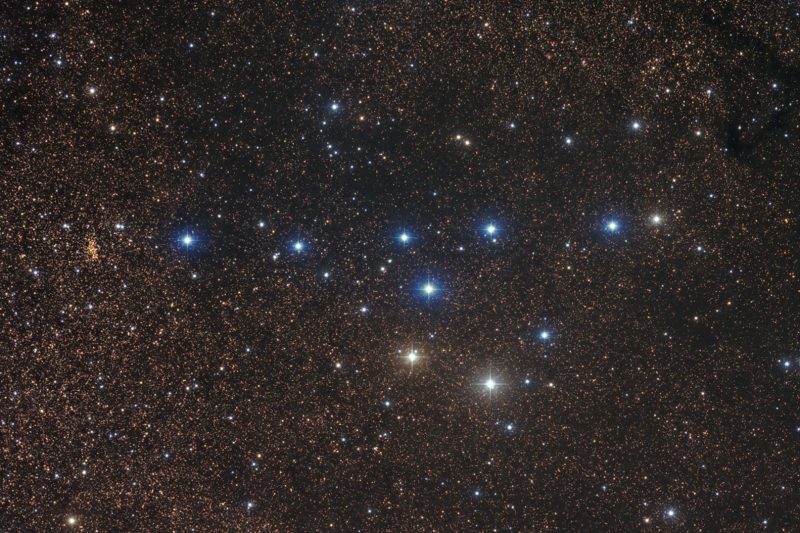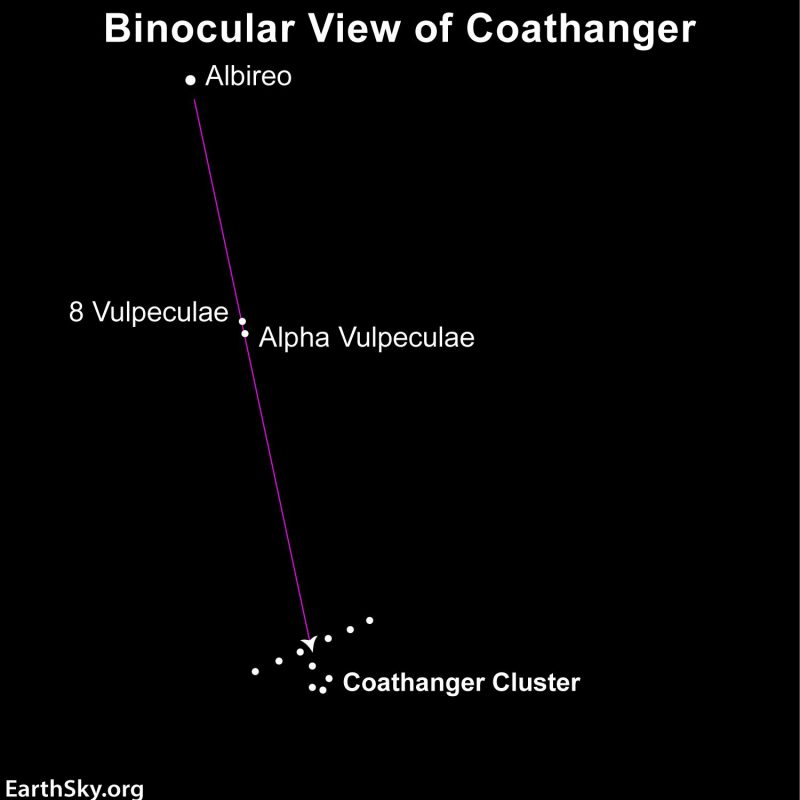
On any evening from July until about November – if you have a dark sky – you can look within the famous Summer Triangle for a tiny but recognizable cluster of stars. Most people call it the Coathanger cluster. Two other names are Brocchi’s cluster and Collinder 399. The Coathanger is a tiny asterism, or pattern of stars (not a constellation).
It isn’t a true open star cluster, but only a chance alignment of physically unrelated stars.
It looks like its namesake, making it easy to spot with binoculars and a dark sky. But you have to know just where to look. It’s visible from both the Northern and Southern Hemispheres.
Coathanger cluster within the Summer Triangle
Do you already know the Summer Triangle stars? If not, click here. The Summer Triangle is easy to spot as a large triangle in the east on northern summer evenings. Three bright stars mark its corners: Deneb in the constellation Cygnus the Swan, Vega in Lyra the Harp, and Altair in Aquila the Eagle.
The Milky Way – the edgewise view into the flat disk of our galaxy – runs right through the Summer Triangle. So there are many beautiful little clusters here, plus, of course, the great and glorious Dark Rift of the Milky Way.
If you can find the Summer Triangle, you can find the Coathanger. Just be sure to look from a dark rural location, and have some binoculars handy. The cluster is located along a line between two Triangle stars, Vega and Altair. The image below illustrates the view.

Albireo can help you find the Coathanger
First – to find the Coathanger – you need to find a slightly fainter star, beloved Albireo. This star is located in the midst of the Summer Triangle. It’s also seen as the bottom of a second asterism within the Summer Triangle, called the Northern Cross.
Albireo is found at the base of the Northern Cross.
Albireo to Alpha Vulpeculae to the Coathanger
Got Albireo? Now for some specifics on finding the Coathanger. With binoculars, look for the brightest star in the vicinity of Albireo. That star is called Alpha Vulpeculae, which appears as a double star through binoculars (though the two stars are not gravitationally bound).
Draw an imaginary line from Albireo through Alpha Vulpeculae to locate the Coathanger. In most binoculars, Alpha Vulpeculae and the Coathanger fit within the same binocular field of view, though just barely.
Notice that six stars form the bar of the Coathanger, while four stars make up the hook. From mid-northern latitudes, the Coathanger often appears upside-down. That’s why some people call it the Ski Lift.


When should you look?
Our sky chart above shows the stars as they appear from the Northern Hemisphere in middle July around midnight (1 a.m. daylight saving time).
Because the stars return to the same place in the sky some two hours earlier with each passing month, this sky chart also shows star positions for about 10 p.m. (11 p.m. daylight time) in mid-August, 8 p.m. (9 p.m. daylight time) in mid-September and 6 p.m (7 p.m daylight time) in mid-October.
Since these stars shine from south to overhead at these times (as seen from the Northern Hemisphere), you might want to sprawl out on a reclining lawn chair, with your feet pointing southward. A reclining position saves neck strain.
The Coathanger’s position is RA: 19h 26.47′; Dec: 20o 11.93′
Bottom line: Star-hop to the Coathanger – a tiny asterism that really looks like its namesake – via the stars Albireo and Alpha Vulpeculae.
Enjoying EarthSky so far? Sign up for our free daily newsletter today!
The post Coathanger cluster: It does look like its name first appeared on EarthSky.
from EarthSky https://ift.tt/PBgdjqT

On any evening from July until about November – if you have a dark sky – you can look within the famous Summer Triangle for a tiny but recognizable cluster of stars. Most people call it the Coathanger cluster. Two other names are Brocchi’s cluster and Collinder 399. The Coathanger is a tiny asterism, or pattern of stars (not a constellation).
It isn’t a true open star cluster, but only a chance alignment of physically unrelated stars.
It looks like its namesake, making it easy to spot with binoculars and a dark sky. But you have to know just where to look. It’s visible from both the Northern and Southern Hemispheres.
Coathanger cluster within the Summer Triangle
Do you already know the Summer Triangle stars? If not, click here. The Summer Triangle is easy to spot as a large triangle in the east on northern summer evenings. Three bright stars mark its corners: Deneb in the constellation Cygnus the Swan, Vega in Lyra the Harp, and Altair in Aquila the Eagle.
The Milky Way – the edgewise view into the flat disk of our galaxy – runs right through the Summer Triangle. So there are many beautiful little clusters here, plus, of course, the great and glorious Dark Rift of the Milky Way.
If you can find the Summer Triangle, you can find the Coathanger. Just be sure to look from a dark rural location, and have some binoculars handy. The cluster is located along a line between two Triangle stars, Vega and Altair. The image below illustrates the view.

Albireo can help you find the Coathanger
First – to find the Coathanger – you need to find a slightly fainter star, beloved Albireo. This star is located in the midst of the Summer Triangle. It’s also seen as the bottom of a second asterism within the Summer Triangle, called the Northern Cross.
Albireo is found at the base of the Northern Cross.
Albireo to Alpha Vulpeculae to the Coathanger
Got Albireo? Now for some specifics on finding the Coathanger. With binoculars, look for the brightest star in the vicinity of Albireo. That star is called Alpha Vulpeculae, which appears as a double star through binoculars (though the two stars are not gravitationally bound).
Draw an imaginary line from Albireo through Alpha Vulpeculae to locate the Coathanger. In most binoculars, Alpha Vulpeculae and the Coathanger fit within the same binocular field of view, though just barely.
Notice that six stars form the bar of the Coathanger, while four stars make up the hook. From mid-northern latitudes, the Coathanger often appears upside-down. That’s why some people call it the Ski Lift.


When should you look?
Our sky chart above shows the stars as they appear from the Northern Hemisphere in middle July around midnight (1 a.m. daylight saving time).
Because the stars return to the same place in the sky some two hours earlier with each passing month, this sky chart also shows star positions for about 10 p.m. (11 p.m. daylight time) in mid-August, 8 p.m. (9 p.m. daylight time) in mid-September and 6 p.m (7 p.m daylight time) in mid-October.
Since these stars shine from south to overhead at these times (as seen from the Northern Hemisphere), you might want to sprawl out on a reclining lawn chair, with your feet pointing southward. A reclining position saves neck strain.
The Coathanger’s position is RA: 19h 26.47′; Dec: 20o 11.93′
Bottom line: Star-hop to the Coathanger – a tiny asterism that really looks like its namesake – via the stars Albireo and Alpha Vulpeculae.
Enjoying EarthSky so far? Sign up for our free daily newsletter today!
The post Coathanger cluster: It does look like its name first appeared on EarthSky.
from EarthSky https://ift.tt/PBgdjqT

Aucun commentaire:
Enregistrer un commentaire